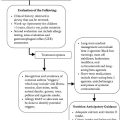6.1 Nephrotic Syndrome
6.1.1 Name of Disorder
Nephrotic syndrome.
6.1.2 Clinical Definition
Nephrotic syndrome is not a disease but a constellation of clinical findings common to a number of renal disorders: proteinuria >50 mg/kg per 24 hours (>40 mg/m2 per hour or a protein-to-creatinine ratio >2); hypoalbuminemia (serum albumin <3 g/dL); edema and hypercholesterolemia are commonly present.
6.1.3 How It Is Diagnosed
Test for serum albumin, creatinine, blood urea nitrogen (BUN), electrolytes, and urinalysis. A kidney biopsy may be performed. Other labs of interest include a thyroid panel, complete blood count (CBC), calcium, 25-OH vitamin D, and a fasting lipid panel.
6.1.4 Nutritional Implications
Low sodium (Na+) diet. At risk for hyperglycemia and hyperlipidemia.
6.1.5 General Nutrition Guidelines
1. Low-sodium diet:
- 1–3 mEq/kg, or 23–69 mg/kg.
- The level of restriction depends on severity of edema and/or presence of hypertension.
2. If patient is edematous, consider fluid restriction.
3. Ensure adequate calcium and vitamin D intake; supplement as indicated.
4. If patient is on a prednisone treatment, consider additional calcium and vitamin D. If hyperglycemia is present, consider a carbohydrate-controlled diet as needed.
5. If hyperlipidemia is present, recommend a low-fat diet as appropriate and if able to meet caloric needs.
6.1.6 Pearls
- A high-protein diet is generally not recommended because it causes increased urinary protein losses.
- The edema associated with nephrotic syndrome can be so severe as to limit mobility.
- The reason for the increased hepatic production of lipoproteins during the nephrotic state is not entirely understood, but it may be linked to low plasma oncotic pressure or defects in lipoprotein catabolism.
Nutritional Algorithm for Chronic Kidney Disease (CKD)
Stay updated, free articles. Join our Telegram channel

Full access? Get Clinical Tree






